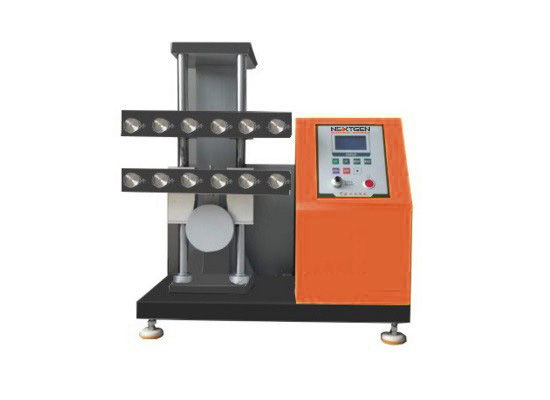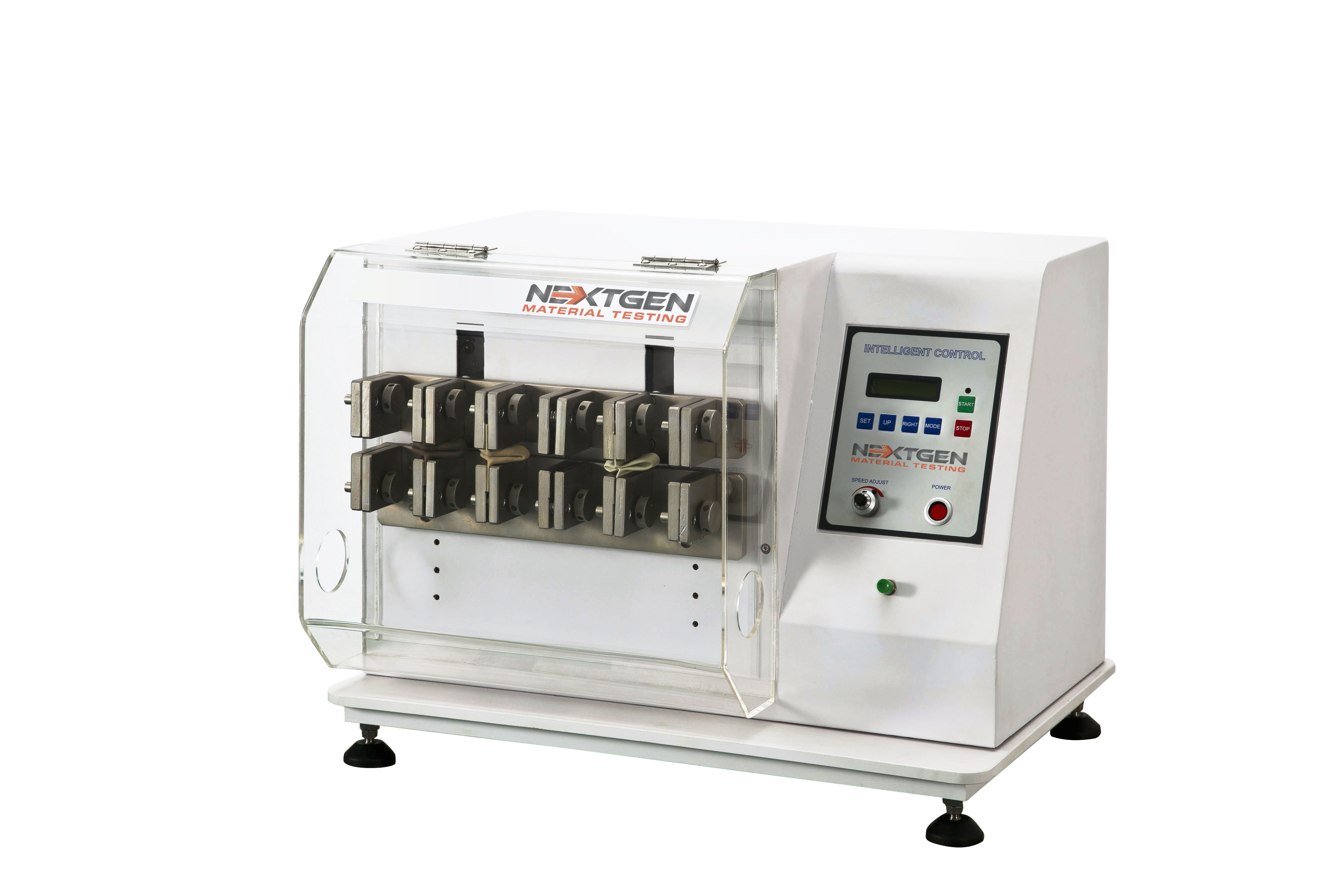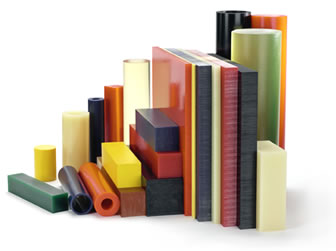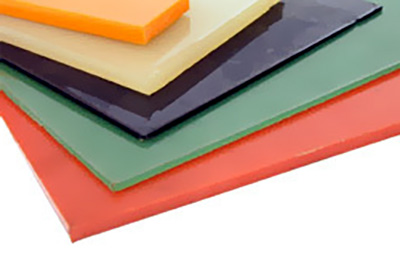
Rubber products need to be tested in terms of the ability of the material to withstand repeated flexing without developing cracks. We’re talking about testing of rubber materials here, specifically.
The flexing endurance of rubber materials is determined via a laboratory simulation wherein specimens are subjected to repeated flexing. Testing is done under accepted standards of flex degree, mode, and speed.
One of the machines available and used in such a test is the DeMattia Flex Cracking Tester.
If you decide that you will use this machine, get a truly certified DeMattia tester, because you want to make sure that the technical level, conditions and the working and general parameters of the machine satisfy the requirements for the type of test you need to implement.
Is DeMattia testing right for you? Here is useful information to guide you.
DeMattia Testing System

This testing system is basically a fatigue test under flexing, and is carried out based on ISO 132*. In general, fatigue tests use a loading-unloading method.
Fatigue is defined as a change in a material’s properties caused by prolonged action of strain and stress, though this definition may include stress relaxation and creep.
Fatigue, for our particular discussion, covers only changes that result from repeated cyclic deformation. In other words, fatigue is a dynamic testing done over numerous repetitive cycles.
First, the sample is loaded into the tester using a predetermined test stress. The sample is then unloaded to either an opposite load or zero load. This loading-unloading cycle is repeated until the desired number of cycles is achieved.
Factors affecting fatigue testing
Subjecting a rubber material to deformation cycles alters its stiffness quality and its mechanical strength. For many rubber products such as belts and shoes, even a tiny change in strength or stiffness matters a lot.
The type of breakdown experienced by the material depends not only on the force applied, but also on the environmental conditions, as well as the material’s geometrical attributes.
In atigue testing, parameters such as oxidation, attack by ozone and thermal degradation are also taken into account.
For instance, in rubber materials used in making tires, failure by fatigue takes into account sidewall cracking and groove, and also heat buildup. Thus, logically a reliable test should be able to define numerically these various factors contributing to the degradation of the material being tested.
With the DeMattia testing in particular, continuous movement or flexing is applied to test how much bending or flexing a material can take before it develops cracks. The DeMattia tester performs 60 to 300 flex cycles per minute.
There are two testing methods used:
- Flex cracking – determines how long it take before cracking takes place
- Crack growth – measures crack growth after intentionally cutting the specimen
Flex-cracking vs cut-growth test
Most of the flex-cracking tests involve straining the test sample in flexure. The result closely represents that type of deformation the material will undergo when already in service in products such as footwear, tires and belts.
However, despite the clear logic in using such an approach, there are setbacks, and one of them is that the bending of the test sample is quite difficult to control.
This is due to the different modulus in different rubber materials, and the fact that the fatigue life of the material is sensitive to the amount of strain applied, unreliable data can be obtained.
The cut-growth method is particularly applicable to situations where the sample is resistant to initiation of cracking. The technician then makes a cut or tear in the material.
The problem with this method is that the cut may rapidly increase in size under a given strain, though initially, it is difficult to achieve cracking in the material with the flex-crack method.
DeMattia Flex Cracking Tester
The DeMattia machine’s essential features are as follows:
- Adjustable stationary heads with grips for holding one end of specimens (fixed position). There are also moving heads below functioning as holders of the other end of the specimens.
- The moving heads are installed into the machine in such a way that they move in a straight direction in the same spatial plane where the upper grips are exactly located.
- The maximum length of travel that the moving grips are allowed to make is 100 mm.
- The flexing operation may be set in such a way that all specimens are flexed simultaneously while hanging on a single bar.
Specimens
The recommended number of specimens for each sample is at least three. The average of results from the specimens is computed.
Follow instructions on sample preparation. The shape and dimensions are described in the manual, and basically, they should be cut strips with surface that’s smooth and free of irregularities.
Measure the thickness of specimens. Only results from specimens with thickness of 6.4 ± 0.1 mm are acceptable. Test specimens must be conditioned for at least 12 hours according to the temperature requirement for sample preparation.
Machine Adjustment
There is a requirement for the machine before operation. The stationary and movable heads should be positioned and adjusted so that they approach each other to a distance of 19 mm for each flex stroke.
Types of Flex Test According to ASTM
The American Society for Testing and Materials (ASTM) provides the codes for DeMattia testing. The organization assigns the code ASTM D-430 for DeMattia test where cracking is produced by bending, and measure of performance is determined by the number of flexes performed until cracking is initiated.
Alternatively, ASTM assigns the code ASTM D-813 for tests that require cutting of the specimen to initiate cracking. Here, the crack length achieved is observed, and the number of flexes made to achieve such length is recorded.
If the DeMattia machine and the Ross Flexer machine are compared, you will find significant difference in performance. ASTM assigns the code ASTM D-1052 for the Ross Flexer, a test that also measures cut growth by repeated bending.
When the Ross notched test (rate = 100 cycles per minute) was applied on urethane, a material that has excellent flex life, no cut growth was observed after 420,000 flexes (72 hours).
On the other hand, the DeMattia test at 300 cycles per minute, was able to cause failure (24 hours) using a notched specimen. More DeMattia tests also revealed that the machine can only cause slight cracking on urethane on a longer run of 100 hours.
Urethane Internal Heat Buildup


The urethane material is used here for the purpose of explaining heat buildup in materials as a factor to consider when testing. In the case of urethane, what is found is that heat buildup in the material exceeds heat buildup in other conventions’ elastomers.
It was also observed that urethane has low thermal conductivity, making it difficult for heat to quickly dissipate. Such attributes make it easily susceptible to premature failure. Thus, when designing with urethanes, it is important that heat buildup be taken into account.
Heat dissipation is therefore key in minimizing the adverse effects, and one way to do that is by employing thin cross sections from which heat can easily be dissipated.
An example in production would be truck wheels made of urethane, where thinner sections of the material improved service life. Adverse effects were noted in the old tires, but with the new design, excessive heat buildup was controlled.
By increasing the hub size and also by reducing the thickness of urethane parts on the tires, heat is easily dissipated and performance is hugely improved.
Benefits of DeMattia Flex Cracking Tester
Depending on the model that you will use, the machine can give benefits in several ways:
- Simultaneous testing of several specimens – the more data you have, the more reliable your results will be. Some models allow simultaneous testing of 5 to 20 specimens.
- Performs fully automatic tests – the machine can automatically perform the test and provide images on a PC
- Touch panel screen with dialogue – operate the machine with guide from the intuitive dialogue system.
- Easy recognition of crack width – this machine allows easy measurement of crack width, manually or automatically. In case the width is hard to recognize, the machine will give correct measurement afterwards.
- Provides S-N curves – You will be given a curve from each test piece. Results are also provided on a file.
- Easy setting up of test pieces – These machines are equipped with a wheel lever for easy setting up of specimens prior to testing.
The DeMattia testing machine allows for testing several materials at different speeds. Materials that can be tested include plastics, fiber optics, and leather. The machine is designed with simple use and durability in mind. The rigidity of this tester allows generation of accurate results.
The machine is very useful in different production settings and needs, such as:
- Quality products inspection and reporting
- Inspection checks for ensuring on-spec product for converting processes
- Settings and adjustment for production additives
The DeMattia machine is specifically useful in the automotive, rubber and textile industries. Household products that can be greatly improved with the use of this machine are rug backings, faucet washers, aquarium tubing, hot water bottles, bathtub plugs, cushion, pillows, mattresses, raincoats, pond liners, boots, and so on.
Where to buy a DeMattia Flex Cracking Tester
Should you decide to get this machine, there are many suppliers to source it from. However, check for reliability and customer aftersale support, as you might need assistance if you’re using this machine for the first time.
Also, check suppliers that offer affordable DeMattia Tester, where you can get the machine at the best price, so probably you have to spend a little more time researching for that.
You may also need other testing machines for your other products, so it’s best to make a deal with a company that offers various testing machines and has great experience in different testing fields – metal testing, plastic test, abrasion test, soil mechanics and so on.
Take note of warranty offers and wholesale discount offers. These machines can cost an arm and a leg for your operations, so make sure that you deal with a company that cares for your budget along with readiness for technical support.
*ISO 132 – This ISO specification is specifically intended for flex testing that uses the DeMattia testing machine and defines the appropriate method for such type of test.